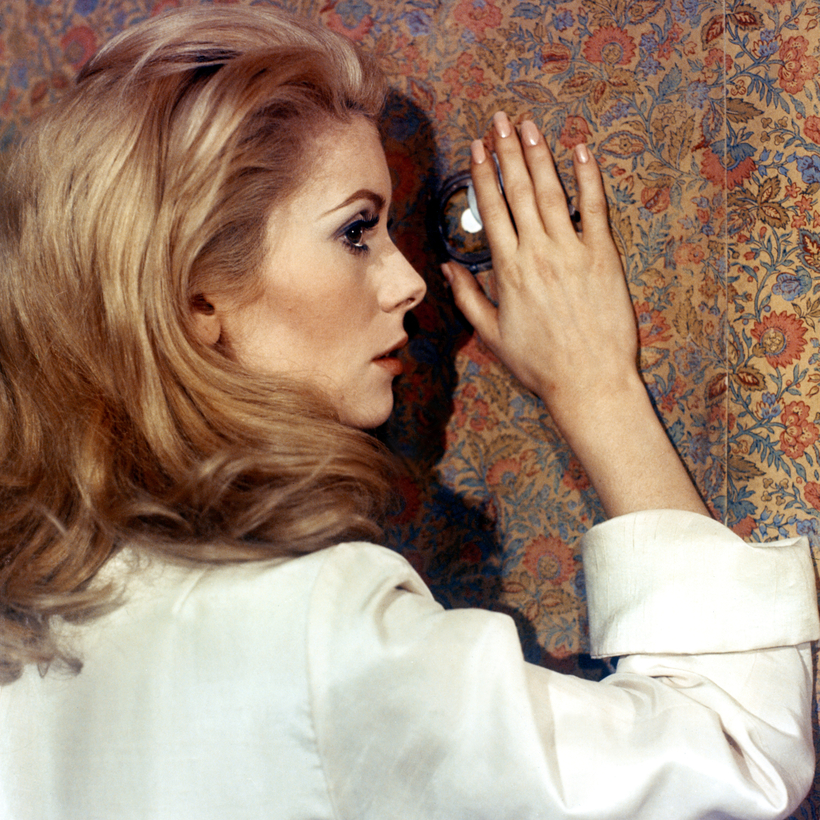I don’t know about you, but I’m in the mood for something macabre and ghoulish, and a new skin-tightening procedure delivers big-time. It’s called Ellacor, and it uses the brand’s proprietary Micro-Coring technology. If that brings to mind carving pumpkins, well, good: ’tis the season.
In this new, F.D.A.-approved procedure, small, hollow needles in a handheld gun puncture the face, pulling out a “fraction of a millimeter of the skin,” says Dr. Robert Anolik, a board-certified dermatologist and professor at the N.Y.U. Grossman School of Medicine. He pricks the face thousands of times, until it looks like a Chuck Close painting. As the skin heals, it shrinks, tightens, and produces more collagen and elastin—all of which eventually make the face look less lined, less saggy, and more plump.
Before he showed me pictures of the procedure, Dr. Anolik asked, “You can handle seeing blood, right?” You bet I can! The images, unfortunately, weren’t gory at all.
Is it painful? Take a wild guess. The doctor applies a numbing cream first and then injects the skin with lidocaine, both to anesthetize it and minimize bruising and bleeding. Afterward, “there’s a little scabbing. The skin is pink and swollen for about a week,” Dr. Anolik says. In its clinical trial, Ellacor reports that “70 percent of patients were comfortable going out in public or returning to work three days after treatment”—to which I say, “Define ‘comfortable.’” To get the best results, Ellacor recommends three treatments in 30-day increments. That’s a lot of Zoom calls with the video off.
If this sounds barbaric, then welcome to the world of cosmetic dermatology, where controlled, intentional damage is the modus operandi. Lasers burn the skin, ultrasound and radio-frequency waves heat the tissue beneath, acids dissolve the surface cells, and Botox paralyzes the muscles—all to encourage healing, smoothing, and/or tightening. Ellacor, join the party!
A Side of Olive Oil, Please. On My Cheekbone
Does anyone—besides a much married singer-actor who makes 53 look like the new 20 (J.Lo)—really want to spread olive oil on their face and call it skin care? Olive oil is thick, viscous, olive-y, oily. Please, your face is not a piece of bruschetta.
There may be something to it, though. A new skin-care serum and cream with ingredients from one of the oldest olive-oil producers in Italy actually has the backing of legitimate science. Beauty Thinkers is the name of the line, and if that’s a head-scratcher, then try spending a few hours with two charming professors, Stefano Manfredini and Silvia Vertuani, from the University of Ferrara, as they explain the molecular structure of … something. Time to turn in your Mensa membership.
The Beauty Thinkers products are made from a substance extracted from the wastewater of the olive-oil-pressing process. Or something like that. The ingredient, hydroxytyrosol (let’s call it HT), is a wildly potent antioxidant. The professors have studied HT for 20 years and tested it every which way.
If you haven’t attended a graduate course in cosmeceuticals taught, ideally, by these professors, then let me try to explain. “It’s not so simple to understand,” Professor Manfredini says, sympathetically.
It isn’t enough to shove even the most impressive antioxidant into a cream or oil and offer it to the skin-care-consuming public. The antioxidant has to be stabilized, which the professors achieved with a particular technology. The HT molecule is small enough to penetrate the skin and potent enough to protect skin cells against oxidative damage (from the sun, pollution, and other environmental aggressors). And from there, it increases the skin’s collagen levels. Otherwise, what’s the point?
The professors tested and measured it all, endlessly, tirelessly. They compared the antioxidants in Beauty Thinkers against those in the top products globally and found that Beauty Thinkers has more antioxidants—by a lot (300 versus 200)—than the category leader. Not to mention that the category leader is brown and smells strangely meaty. That’s all the professors and I can say; we’re sworn to secrecy.
Don’t try to be clever and shortcut the process with some ordinary olive oil from your neighborhood market. “Regular olive oil is too purified,” says Manfredini. My advice is to use Beauty Thinkers in a carefree, even thoughtless way, knowing that somewhere in Italy someone has done the mental acrobatics so you don’t have to.
But Does It Actually Cover Anything?
If your face is contoured like a Modigliani painting, if your eyebrows are microbladed and laminated, your lashes extended, your lip line carved beyond its natural borders, and your foundation spread like cake frosting from hairline to cleavage, then this is not for you.
For the rest of us who perhaps find most foundation to be suffocating, thick, slightly creepy, and a beast to apply without a battery of tools and an uninterrupted hour or two, then sit right down. Pour yourself a glass of orange wine. Relax.
The new Les Beiges Water-Fresh Complexion Touch, from Chanel, is like a gentle whisper. It comes in a pump bottle filled with festive bubbles of pigment suspended in water. When you use the included brush—a small, soft, domed wonder—the beads pop and form a smooth tint that feels like nothing but works astonishingly well.
You don’t have to be deft; you don’t even have to pay much attention. Just pump out two tiny dabs on the back of your hand, drag the brush over them, and swipe under your eyes, down your nose, around your nostrils, and everywhere in between. Done! It makes your complexion remarkably even without feeling coated. And your hand—where you blended the beads—looks quite fetching.
Consider it a comfortable veil of coverage, not a full, opaque layer of Spackle. Foundation for foundation-phobes.
You Smell. In a Good Way
Those searching for a new fragrance but confounded about where to start might want to wander over to Frédéric Malle’s Web site and play the game he’s developed to match personality with parfum. It’s also excellent for procrastinators.
Malle, in his 22 years as a fragrance sorcerer for Editions de Parfums Frédéric Malle, is responsible for elevating the art of perfumery and making it more accessible without dumbing it down or cheesing it up. He honors the perfumers behind each blend by putting their names on the labels (Carnal Flower, by Dominique Ropion; Musc Ravageur, by Maurice Roucel). His boutiques are outfitted with a glass-and-steel contraption that he calls a smelling machine. It looks like a shower stall and emits a fragrance of choice. You step in and inhale without committing your pulse points to it.
“When you’re shopping for a perfume, it’s a very formal experience,” Malle says, with some disdain. He believes, instead, in starting with an exploration of the self. “Consider perfume a portrait of its wearer,” he wrote about Portrait of a Lady, one of his best-sellers. “The sound of her voice, her gaze, the way she plays cards.” Cards?
It’s all very French. He tells me that when Catherine Deneuve studies for a role, she selects a perfume for the character she’s portraying. Malle brings that idea to people who aren’t legends of the French cinema to make fragrance recommendations. “You have to understand who you’re dealing with and visualize where they’re going to wear the perfume.”
And that’s where the fun comes in. To find your scent, click on a series of illustrations by Konstantin Kakanias of clothes, hairstyles, accessories, shoes, cars, lingerie, and places you plan to wear the fragrance. The algorithm, or Malle himself, somewhere in the cloud, processes the answers and offers three suggestions. When I play the game as my true, bland self, I’m advised to try En Passant, L’Eau d’Hiver, and Rose & Cuir—two of which I actually wear. When I pretend I’m a mad, feather-clad, Rolls-Royce-driving party person, I get Carnal Flower, Musc Ravageur, and the Night, scents I admire but that are not, no matter how I try, me. When I answer the quiz as Deneuve in Belle de Jour, I come up with Iris Poudre, Carnal Flower, and Portrait of a Lady, which could be shorthand for Belle’s contradictory character.
En Passant, c’est moi.
Linda Wells spent 25 years as Allure magazine’s founding editor, served as Revlon’s chief creative officer, and currently consults and sits on the boards of several beauty and apparel companies


